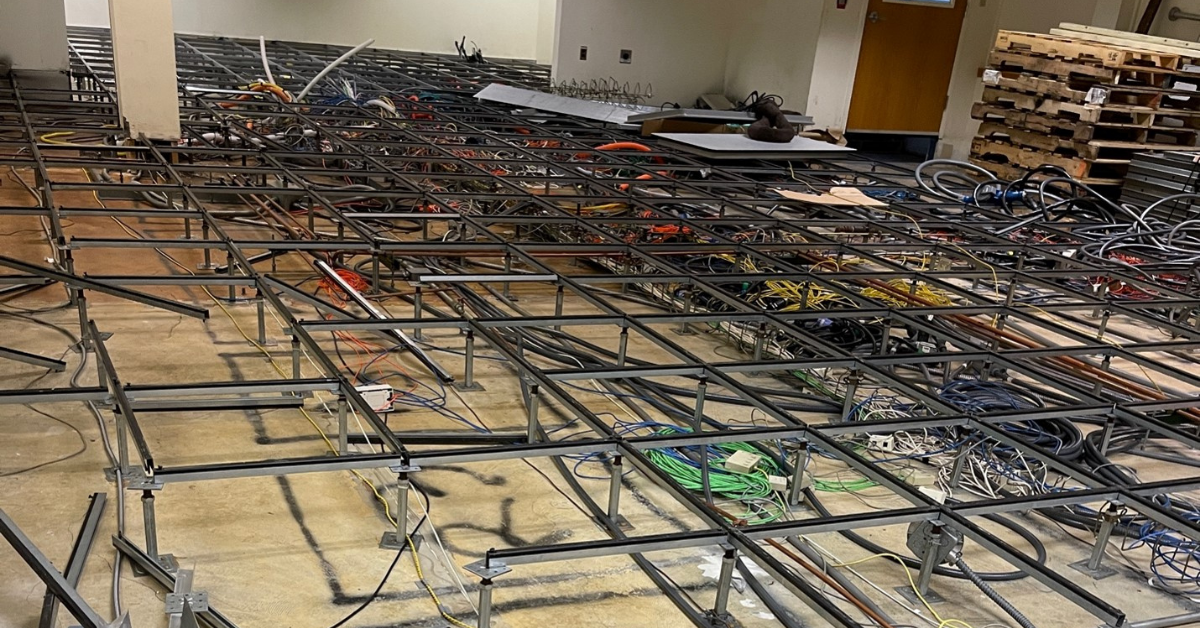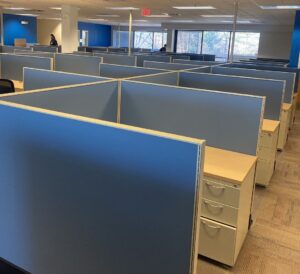
Apple Leisure Group is a “leading North American resort brand-management, travel and hospitality group” that was acquired by Hyatt Hotels Corporation in November of 2021. After this merger, the company reorganized some of its core businesses, ended its lease on a key facility, and needed to vacate an 80,000 square foot office building which the company had customized to its needs over many years as a tenant.
With the complexity of this project, Apple Leisure Group sought out Meyer to formulate a comprehensive plan utilizing its Workplace Solutions capabilities and team to handle this significant decommissioning job.
Apple had occupied the building in Newtown Square, PA for years and integrated a significant number of customized workspaces and technology into this facility. This included more than 300 workstations, 60 office suites, and 12 conference rooms over two floors. It also included a main server room and 6 IDF closets with state-of-the-art cooling systems, fire suppression, and industrial-grade Uninterrupted Power Supplies installed on a raised tile floor to conceal the plumbing and wiring. To connect all these spaces and technology, there were miles of cat5 cables and plumbed-in connections installed throughout the building, as well.

These business-critical systems needed to stay operational throughout this transition and the entire job needed to be complete in 2.5 weeks. The landlord also had high standards for how the space was to be vacated, essentially leaving no sign of the technology infrastructure and customization that had been done to the space over the years. These included additions like Dictaphone systems, A/V customizations, and electrical upgrades. There was also rewired building control systems that were tied directly into Apple’s infrastructure, including access control systems and thermostats, as well as critical infrastructure backups. This is highly unusual and required particular expertise and care to ensure that both the building and Apple’s operations were not impacted.
To help finalize its lease/occupancy in the most advantageous way, Apple Leisure worked with the Meyer team to plan and execute this complex decommissioning project.
The Meyer team disassembled the hundreds of workstations, offices, and conference rooms, and in the process removed 42 truckloads of furniture and material from the location.
As the last of the furniture was being relocated and the Meyer team moved on to the server room, an issue developed with the network that would not allow for key elements of the technology to be moved. Meyer worked with Apple’s IT team to determine what could be removed, traced lines to ensure nothing was disconnected improperly, and began the removal of the infrastructure to hold true to the deadline. Once the network was successfully transferred, Meyer was able to put focus back on relocating the server room. The large equipment was removed and with a rapidly approaching deadline Meyer’s plumbing, electrical, fire suppression, and low voltage cabling crews worked elbow to elbow to complete these portions of the decommission.
The Meyer team managed the disposal of hazardous materials and other debris as well and cleaned the space to leave it in “broom-swept” condition.
Meyer’s team helped Apple Leisure decommission and vacate their facility within the confines of an exacting timeline. Apple’s operational teams continued to function with minimal disruption throughout the entire duration of the relocation and the space was returned in a clean and orderly state that satisfied the landlord’s lease requirements.
“The Meyer team rocked the house on this project and went above and beyond in their work” said Troy Jilot, Sr. IT Manager for Apple Leisure Group. “They navigated a very complex decommissioning on a tight timeline and helped us meet our objectives for this business-critical transition.”
Meyer’s team helped Apple Leisure decommission and vacate their facility within the confines of an exacting timeline. Apple’s operational teams continued to function with minimal disruption throughout the entire duration of the relocation and the space was returned in a clean and orderly state that satisfied the landlord’s lease requirements.
“The Meyer team rocked the house on this project and went above and beyond in their work” said Troy Jilot, Sr. IT Manager for Apple Leisure Group. “They navigated a very complex decommissioning on a tight timeline and helped us meet our objectives for this business-critical transition.”